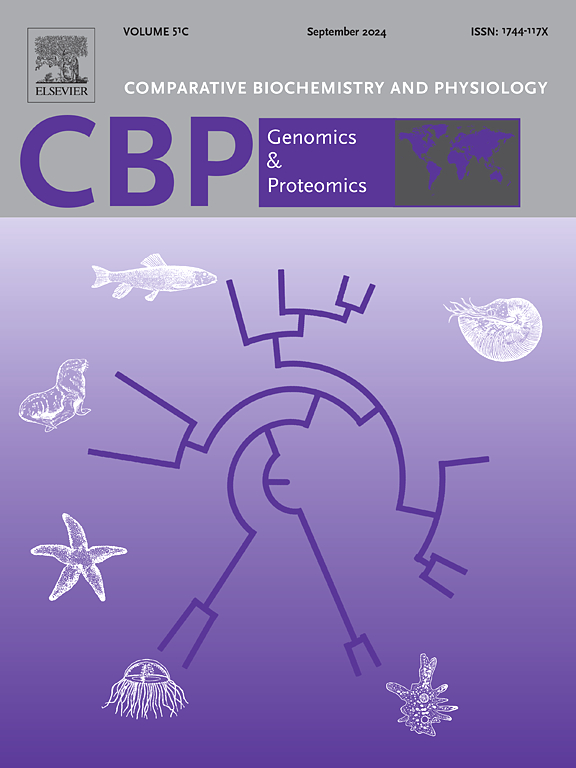Comprehensive analysis of the transcriptome implicated in the immune response of Procambarus clarkii to Aeromonas hydrophila
IF 2.2
2区 生物学
Q4 BIOCHEMISTRY & MOLECULAR BIOLOGY
Comparative Biochemistry and Physiology D-Genomics & Proteomics
Pub Date : 2025-05-07
DOI:10.1016/j.cbd.2025.101528
引用次数: 0
Abstract
In order to better understand the immune response of Procambarus clarkii to Aeromonas hydrophila injection, the transcriptome data of the gill tissue of P. clarkii were compared and analyzed. 1008 significant DEGs were identified in A. hydrophila infected and PBS control groups, including 411 up-regulated genes and 597 down-regulated genes. Endocytosis, phagocyte and lysosome were the most clustered pathways of DEGs in KEGG database. RNA-Seq results were validated through the verification of immune-related differentially expressed genes (DEGs), whose expression levels were assessed using quantitative real-time PCR (qRT-PCR). With the increase of treatment time of A. hydrophila, the total protein in gill of the treatment group showed a trend of increasing first, then decreasing and then increasing and decreasing. ACP and AKP both show a trend of rising first, then falling and then rising. The results of comprehensive research showed that crayfish infected with A. hydrophila caused damage to gill tissue, and the related immune genes were up-regulated and the immune mechanism was operated to protect the body from A. hydrophila. The differential gene MRC1 was screened through the transcriptome, and to further understand its impact, it was disrupted by RNAi technology, which showed a significant down-regulation of immune genes (TAB2, TLR3, ALF6, Lyso3, clotting factor G beta subunit-like and coagulation factor X-like) as well as genes downstream of the pathway (AP4E1, ARSB and TUBA1A). This study provides a theoretical basis for further exploring the immune adaptability of aquatic animals under bacterial infection.

与克氏原螯虾对嗜水气单胞菌免疫反应相关的转录组综合分析
为了更好地了解克氏原螯虾对嗜水气单胞菌注射的免疫反应,对克氏原螯虾鳃组织转录组数据进行了比较和分析。在嗜水单胞菌感染组和PBS对照组共检测到1008个显著的deg,其中上调基因411个,下调基因597个。KEGG数据库中,吞噬作用、吞噬细胞和溶酶体是deg聚集最多的途径。通过验证免疫相关差异表达基因(DEGs)来验证RNA-Seq结果,并使用实时荧光定量PCR (qRT-PCR)评估其表达水平。随着嗜水单胞菌处理时间的延长,处理组鳃中总蛋白含量呈现先增加后减少再增加再减少的趋势。ACP和AKP均呈现先上升后下降再上升的趋势。综合研究结果表明,小龙虾感染嗜水单胞菌后对鳃组织造成损伤,相关免疫基因上调,并运行免疫机制保护机体免受嗜水单胞菌的侵害。通过转录组筛选差异基因MRC1,为进一步了解其影响,通过RNAi技术对其进行干扰,结果显示免疫基因(TAB2、TLR3、ALF6、Lyso3、凝血因子G β亚基样和凝血因子x样)以及该通路下游基因(AP4E1、ARSB和TUBA1A)均显著下调。本研究为进一步探索水生动物在细菌感染下的免疫适应性提供了理论依据。
本文章由计算机程序翻译,如有差异,请以英文原文为准。
求助全文
约1分钟内获得全文
求助全文
来源期刊
CiteScore
5.10
自引率
3.30%
发文量
69
审稿时长
33 days
期刊介绍:
Comparative Biochemistry & Physiology (CBP) publishes papers in comparative, environmental and evolutionary physiology.
Part D: Genomics and Proteomics (CBPD), focuses on “omics” approaches to physiology, including comparative and functional genomics, metagenomics, transcriptomics, proteomics, metabolomics, and lipidomics. Most studies employ “omics” and/or system biology to test specific hypotheses about molecular and biochemical mechanisms underlying physiological responses to the environment. We encourage papers that address fundamental questions in comparative physiology and biochemistry rather than studies with a focus that is purely technical, methodological or descriptive in nature.

 求助内容:
求助内容: 应助结果提醒方式:
应助结果提醒方式:


